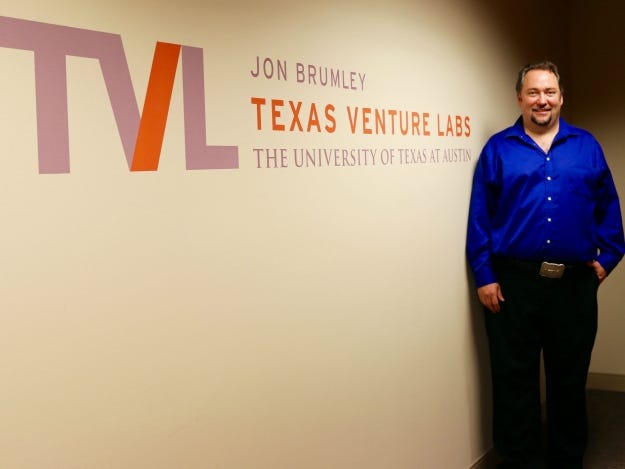Lean Startup Essentials from Texas Venture Labs

Harlan Beverly, MBA ‘04, a serial entrepreneur who co-founded gaming hardware company Bigfoot Networks while earning his MBA and recently added a Ph.D. in business, has broken new ground once again. This fall semester Beverly, the new assistant director of Texas Venture Labs, is teaching Lean Startup Essentials, a course for undergraduate business students at The University of Texas at Austin. The familiar-sounding course name refers to the method described by Eric Ries, author of the highly popular 2011 book, “The Lean Startup: How Today’s Entrepreneurs Use Continuous Innovation to Create Radically Successful Businesses.” With the lean startup method, entrepreneurs shorten the time to bring a product to market by testing consumer response and adjusting future versions as necessary.
The lean startup approach can be successful, according to Beverly, because it quickly answers entrepreneurs’ important question: Will people pay for my idea?
How widespread is the lean startup method for launching companies?
It’s really big — startups in Silicon Valley and all over the world are using this approach — but it hasn’t yet hit university campuses. There are no other classes I’m aware of that are focused exclusively on lean startup and its methodology.
What makes UT special are programs like Texas Venture Labs that combine real world companies and people like myself who have experience with startups — I founded three of them — interacting with students. Now we can empower our students with the latest methodologies and techniques to help them succeed.
What makes the lean startup method such a popular approach?
It’s super popular because it’s the best way to do it. Rob Adams, the director of Texas Venture Labs, wrote a seminal book on market validation. If you’re launching a startup, you should get market validation. Lean startup is the natural next step. It says, “Let’s get market validation as fast as we can, as cheaply as we can.” That’s just good business.
Will employing the lean startup approach help an entrepreneur to succeed?
Lean startup is not path to success. It doesn’t change that some startups are going to fail and some are going to succeed. What it changes is how cheaply and how quickly you’ll learn that. Then you have to do is decide, “I brought a thousand people to my website and nobody bought my product. Now what?” And it’s that “now what?” that separates an entrepreneur from someone who’s not an entrepreneur.
When you fail, it doesn’t mean that none of your ideas are going to work. It just means that one didn’t. To me, that’s the spirit of entrepreneurship. It’s how fast we learn and then what we do about it.
For someone who wants to employ lean startup, what’s the first step?
Build a two-page website and ask for money. You can create a website for free. The first page can be “Here’s my new idea, here’s a price, buy now.” They can press a “buy now” button and the second page says, “Sorry, we’re not yet ready to start shipping, so sign up for email.” Or the second page can be, “Thanks for your interest. Please fill out this PayPal form to submit your money.” You don’t have to be a programmer to do any of this stuff. In my course, we do that in one class. It can be done in about an hour to an hour and a half by a college student who doesn’t know how to program. Anybody can do it.
That’s the best, cheapest, fastest path to true learning about whether or not your idea is good. You know whether or not people are willing to pay for it.
What industries are making especially good use of the lean startup approach?
There are a number of really exciting things happening in a couple of spaces. We’re seeing the lean startup principle applied in video games. A ton of video games are getting launched on crowdfunding sites and they’re finding out before they write a single line of code whether or not their business idea is going to fly. It’s happening throughout the video game industry. Even super high budget titles are finding out before they build anything if people are willing to pay for it.
Another industry doing it pretty well is this Internet of things movement. They’re also tightening the loop between build, measure, and learn. They’re building early, early prototypes and they’re getting into the hands of early customers. They’re making their customers pay and then they’re getting the feedback.
How do you expect the idea of lean startup to evolve?
I think the term lean startup will die and it will be replaced by something else. But the philosophy that you should first get customer validation is going to last.
Crowdfunding is going to get replaced with more rapid, real products and services that are being delivered as opposed to just an idea. At some point, customers will have been burned enough by not getting what they asked for or not getting it in a timely fashion. It’ll slow us down a little bit, because we’ll have to build real things before we can start asking for money.
I foresee a whole series of new companies that are good at building rapid prototypes for people. You see that with 3-D printing today. There are companies that will 3-D print your idea and you don’t even have to do any CAD design. You just tell them the basic idea for what you want and they’ll do all the work. Those kinds of services are going to continue to evolve to enable lean startup-type companies to get that rapid validation quickly with real products, not just an idea on a Web page.
In terms of entrepreneurship, what changes are coming for UT?
We have this new push towards lean. Within the university, we’re going to see more startups than ever before, hopefully, as a result of my efforts with Texas Venture Labs and my new class. I think we’re going to see a ton more companies getting started and actually making money. It’s one thing to have an idea and start a business, but it’s something else entirely to actually make money, and I like making money.
Interview by Jeremy Simon
Originally published in McCombs Today on September 16, 2015.
About this Post
Share:


